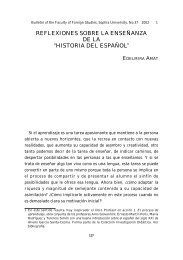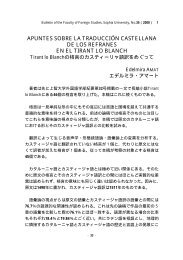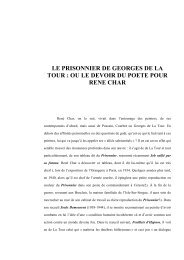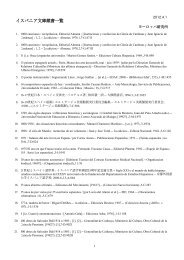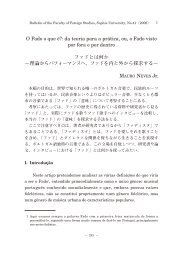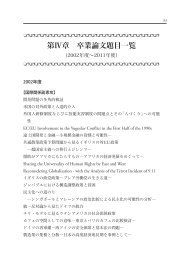Forgotten Paths to NEPA: A Historical Analysis of the Early ...
Forgotten Paths to NEPA: A Historical Analysis of the Early ...
Forgotten Paths to NEPA: A Historical Analysis of the Early ...
Create successful ePaper yourself
Turn your PDF publications into a flip-book with our unique Google optimized e-Paper software.
Joseph DiMen<strong>to</strong> and Kazu<strong>to</strong> Oshio<br />
making in <strong>the</strong> federal government. It required that agencies use a systematic interdisciplinary<br />
approach <strong>to</strong> environmental planning and evaluation in decision-making that might have an impact<br />
on <strong>the</strong> environment. For major federal actions significantly affecting <strong>the</strong> quality <strong>of</strong> <strong>the</strong> human<br />
environment an Environmental Impact Statement (EIS) was mandated. State versions <strong>of</strong> <strong>NEPA</strong><br />
followed and both sets <strong>of</strong> laws covered many actions by <strong>the</strong> government, including <strong>of</strong> energy and<br />
highway agencies.” DiMen<strong>to</strong>, “Environmental Law.”<br />
7 Barry Commoner, “Beyond <strong>the</strong> Teach-In,” Saturday Review, 53 (1970): 50.<br />
8 Richard Lazarus, “The Greening <strong>of</strong> America and <strong>the</strong> Graying <strong>of</strong> Environmental Law,” Virginia<br />
Environmental Law, 20 (2001): 76-77.<br />
9 Richard Lazarus, “The Making <strong>of</strong> Environmental Law,” paper presented at Woodrow Wilson Center,<br />
28 September 2004.<br />
1 0 Rome lists <strong>the</strong> following works on <strong>the</strong> decade as those giving little or no attention <strong>to</strong> environmental<br />
issues: Howard Brick, Age <strong>of</strong> Contradiction: American Thoughts and Culture in <strong>the</strong> 1960s<br />
(New York: Twayne <strong>of</strong> Macmillan, 1998); David Burner, Making Peace with <strong>the</strong> 60s (Prince<strong>to</strong>n:<br />
Prince<strong>to</strong>n University Press, 1996); Dominick Cavallo, A Fiction <strong>of</strong> <strong>the</strong> Past: The Sixties in American<br />
Hi s<strong>to</strong>ry (New York: St. Martin’s, 1999); David Chalmers, And <strong>the</strong> Crooked Places Made<br />
Straight: The Struggle for Social Change in <strong>the</strong> 1960s (Baltimore: The Johns Hopkins University<br />
Press, 1996); David Farber, The Age <strong>of</strong> Great Dreams: America in <strong>the</strong> 1960s (New York: Hill and<br />
Wang, 1994); Todd Gitlin, The Sixties: Years <strong>of</strong> Hope, Days <strong>of</strong> Rage (New York: Bantam Books,<br />
1987); Maurice Isserman and Michael Kazin, America Divided: The Civil War <strong>of</strong> <strong>the</strong> 1960s (New<br />
York: Oxford University Press, 2000); and David Steigerwald, The Sixties and <strong>the</strong> End <strong>of</strong> Modern<br />
America (New York: St. Martin’s, 1995).<br />
1 1 Adam Rome, “‘Give Earth a Chance’,” Journal <strong>of</strong> American His<strong>to</strong>ry 90 (2003): 525-26.<br />
1 2 Rome, “‘Give Earth a Chance’,” 526. According <strong>to</strong> Rome, <strong>the</strong>y include: Terry H. Anderson, The<br />
Movement and <strong>the</strong> Sixties (New York: Oxford University Press, 1995); Edward P. Morgan, The 60s<br />
Experience: Hard Lessons about Modern America (Philadelphia: Temple University Press, 1991);<br />
and James T. Patterson, Grand Expectations: The United States, 1945-1974 (New York: Oxford<br />
University Press, 1996).<br />
1 3 Lazarus, “The Greening <strong>of</strong> America and <strong>the</strong> Graying <strong>of</strong> Environmental Law,” 79-82.<br />
1 4 Joseph L. Sax, “Preface” Creative Common Law Strategies for Protecting <strong>the</strong> Environment, ed.<br />
Clifford Rechtschaffen and Denise An<strong>to</strong>lini (Washing<strong>to</strong>n, D.C.: Environmental Law Institute, 2007),<br />
xvii-xviii.<br />
1 5 Citizens’ right <strong>to</strong> be heard before government agencies transformed <strong>the</strong> natural world was secured<br />
by a landmark 1965 federal court ruling, Scenic Hudson Preservation Conference v. FPC. Brooks,<br />
Karl B., Before Earth Day: The Origins <strong>of</strong> American Environmental Law, 1945-1970 (Lawrence:<br />
University <strong>of</strong> Kansas Press, 2009), 149.<br />
1 6 Samuel P. Hays and Robert Gottlieb tell us much about environmentalism’s origins in earlier<br />
movements for conservation and urban and fac<strong>to</strong>ry reform <strong>of</strong> <strong>the</strong> late 19th century and early 20th<br />
century. These works, Sellers argues, “as well as Thomas Dunlap’s more focused his<strong>to</strong>ry <strong>of</strong> DDT,<br />
seek <strong>the</strong> roots <strong>of</strong> ‘environmentalism’ by tracing back in<strong>to</strong> <strong>the</strong> past those concerns about particular<br />
39






